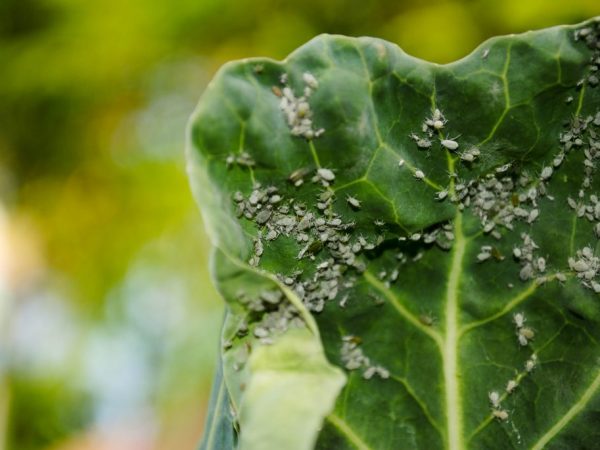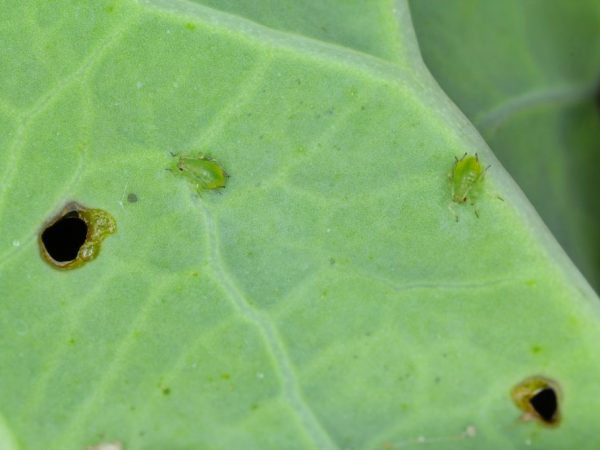Fighting cabbage aphids using folk methods
There are simple and affordable folk methods for fighting aphids on cabbage. These are organic, harmless, and also recipes tested by more than one generation of gardeners.

Fighting cabbage aphids using folk methods
Signs of aphids on cabbage
Cabbage aphid is a greenish insect. Aphids can be winged and wingless.
This is a type of cabbage pest. It attacks seedlings even before the formation of the head, as well as ripe heads of cabbage, affects the upper and root parts.
Sucking out the juice, the insect stops growth and development, the culture withers, and soon completely dies. Traditional methods of fighting aphids on cabbage help prevent and stop the parasite from multiplying.
How to identify the parasite on cabbage
Cabbage aphid is very small, its length is up to 3 mm. Most often, the parasite precipitates the lower leaves of the seedlings and multiplies very quickly. After the defeat, the culture loses its color, turns yellow, twists. The effect is similar to leaf smoldering.
After a while, the vegetable is completely deformed, the sheets roll up into a tube, the development of the culture stops. A characteristic sign of a long stay of aphids is a sticky, unpleasant layer all over the bush.
Why is cabbage aphid dangerous?
Continuing reproduction, aphids form colonies, destroying not only cabbage, but also the nearest neighbors. It is an omnivorous parasite.
Aphids are also a disease vector. According to statistics, early varieties of crops, including cabbage, are most susceptible to pest attacks.
Folk methods of struggle
The mass reproduction of aphids is restrained by bad weather conditions: cold, torrential rains, squall winds. In other cases, you must fight the parasite yourself.
You can protect the vegetable at the stage of planting seedlings. An effective aphid remedy is the right neighbor in the garden. The smell of dill and tomatoes scares off parasites, preventing them from settling on the crop.
Traditional methods of struggle help to get rid of the pest. A suitable recipe is chosen and, following the recommendations, the affected areas are treated. Broths are sprayed in the morning or evening in dry, calm weather.
Tobacco broth
The cabbage parasite does not tolerate tobacco. The concentrated broth is sprayed over the entire crop. For cooking you will need:
- 5 g tobacco;
- 2.5 liters of water.
The ingredients are mixed, they are allowed to brew for a day. Then put on fire, add the same amount of water and cook for 2.5 hours. The solution is sprayed 2-3 times a week.
Vinegar solution

Vinegar will help get rid of pests
The most famous and simplest way to fight a pest is to use vinegar. It has a pungent odor that is not tolerated by parasites. Table vinegar is diluted with water and soapy water:
- a bucket of water;
- 220 ml bite;
- 35 g of soap solution.
All sides of the head are pollinated, especially the lower leaves. They are processed once a week.
Alcohol solution
A solution of ammonia instantly copes with an adult aphid.A large amount of nitrogen leads to severe deformations of the vegetable, therefore, alcohol should be sprayed no more than once every 2 weeks. You will need:
- 5 liters of water;
- 25 ml of alcohol;
- 100 ml of soap solution.
The ingredients are mixed, used through a large spray bottle or watering can. The bottom sheets of the vegetable must be processed.
Ash, cinnamon, pepper
Parasites don't like bright odors. The combination of these ingredients provides an excellent remedy for these pests:
- 15 g cinnamon;
- 15 g red and black pepper;
- 150 g of wood ash;
- 8 liters of non-hot water.
Everything is mixed, processed twice at intervals of 4 days. The procedure is repeated every month.
Tar soap
Tar soap can not only get rid of aphids, but also clean the leaves of the culture from all bacteria and sticky contaminants. It restores the vital activity of the sheets. How to cook:
- 0.5 liters of hot water;
- 50 g of tar soap;
- 4.5 liters of cold water.
The soap is diluted in boiling water, cold water is added, the heads and bottom of the cabbage are sprayed.
Folk remedies are not inferior to store-bought ones. When processing plants, weather conditions (rainy, windy), the area of the affected areas are taken into account.
Prophylaxis
You can prevent the appearance of aphids by observing the following steps:
- in the fall, collect all cabbage stumps, burn them;
- in the spring, when planning the planting of crops, choose the right neighborhood;
- harden cabbage seedlings;
- when planting a crop in holes, add mineral fertilizers, including ash, to the soil;
- process heads of cabbage as a preventive measure.
Prevention does not provide 100% protection. The bottom leaves of the head of cabbage are regularly examined for the presence of parasites. The same is done with neighboring cultures.
Cons of folk remedies
The main disadvantage of folk remedies is their short duration. Pollination is constantly repeated and weather conditions are monitored.
The decoction recipe is simple, but requires skill and additional time. They are extremely careful about ammonia and vinegar.
Conclusion
Regular inspection, care, knowledge of folk methods of struggle and prevention helps to grow cabbage crops without chemical additives.


